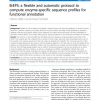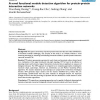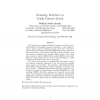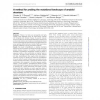439 search results - page 49 / 88 » Maximum entropy methods for biological sequence modeling |
ICDCSW
2002
IEEE
14 years 2 months ago
2002
IEEE
Time-driven Key Sequencing (TKS) is a key management technique that synchronizes the session key used by a set of communicating principals based on time of day. This relatively lo...
BMCBI
2010
13 years 6 months ago
2010
Background: Models for the simulation of metabolic networks require the accurate prediction of enzyme function. Based on a genomic sequence, enzymatic functions of gene products a...
ALMOB
2006
13 years 9 months ago
2006
Background: The sparse connectivity of protein-protein interaction data sets makes identification of functional modules challenging. The purpose of this study is to critically eva...
JCB
1998
13 years 8 months ago
1998
The function of an unknown biological sequence can often be accurately inferred by identifying sequences homologous to the original sequence. Given a query set of known homologs, ...
BIOINFORMATICS
2011
13 years 23 days ago
2011
Motivation: Proteins of all kinds can self-assemble into highly ordered β-sheet aggregates known as amyloid fibrils, important both biologically and clinically. However, the spe...




